Interactions between Climate and Land Cover Change over West Africa
Abstract
1. Introduction
2. Data and Methods
2.1. Study Area
2.2. Data
2.2.1. Land Cover Data
2.2.2. Climate Data
2.3. Methods
2.3.1. Data Preprocessing
2.3.2. Trajectory Analysis, Changed Pixels, and Number of Changes Per Pixel
2.3.3. Land Cover Area Changes
2.3.4. Standardized Climatic Indices
2.3.5. Linking Land–Climate Changes
2.3.6. Average Rate of Climatic Change
2.3.7. Climatic Indices Frequency and Probability of Occurrence
3. Results
3.1. Latitudinal Change Occurrence Frequency
3.2. Land Cover Transition
3.3. Annualized Changes in Land Cover over West Africa
3.4. Climatic Conditions Leading to Significant Land Cover Change Area
3.5. Quantifying Climatic Changes Leading to Abrupt Land Use and Cover Changes
3.6. Quantifying Climatic Changes and Corresponding Land Cover Changes under Normal Climatic Conditions
3.7. Climatic Risks of West Africa: Average Climatic Change
3.8. Climatic Risk of West Africa: Occurrence Frequency and Probability of Occurrence
4. Discussion
4.1. Spatiotemporal Land Cover Changes
4.2. Land Cover Transitions
4.3. Annualized Land Cover Change Intensities
4.4. Climatic Conditions Leading to Significant Land Cover Changes
5. Conclusions
Author Contributions
Funding
Institutional Review Board Statement
Informed Consent Statement
Data Availability Statement
Conflicts of Interest
Appendix


References
- Dale, V.H. The Relationship between Land-use Change and Climate Change. Ecol. Appl. 1997, 7, 753–769. [Google Scholar] [CrossRef]
- Gao, J.; Liu, Y. Climate Warming and Land Use Change in Heilongjiang Province, Northeast China. Appl. Geogr. 2011, 31, 476–482. [Google Scholar] [CrossRef]
- Cotillon, S.E.; Tappan, G.G. Landscapes of West Africa: A Window on a Changing World; United States Geological Survey: Garretson, SD, USA, 2016. [Google Scholar]
- Herrmann, S.M.; Brandt, M.; Rasmussen, K.; Fensholt, R. Accelerating Land Cover Change in West Africa over Four Decades as Population Pressure Increased. Commun. Earth Environ. 2020, 1, 53. [Google Scholar] [CrossRef]
- Deng, X.; Zhan, J.; Su, H. Land Use Impacts on Climate; Springer: Cham, Switzerland, 2014. [Google Scholar] [CrossRef]
- Sylla, M.B.; Pal, J.S.; Wang, G.L.; Lawrence, P.J. Impact of Land Cover Characterization on Regional Climate Modeling over West Africa. Clim. Dyn. 2016, 46, 637–650. [Google Scholar] [CrossRef]
- Diba, I.; Camara, M.; Sarr, A.B.; Diedhiou, A. Potential Impacts of Land Cover Change on the Interannual Variability of Rainfall and Surface Temperature over West Africa. Atmosphere 2018, 9, 376. [Google Scholar] [CrossRef]
- Achugbu, I.C.; Olufayo, A.A.; Balogun, I.A.; Adefisan, E.A.; Dudhia, J.; Naabil, E. Modeling the Spatiotemporal Response of Dew Point Temperature, Air Temperature and Rainfall to Land Use Land Cover Change over West Africa. Model Earth Syst. Environ. 2021, 8, 173–198. [Google Scholar] [CrossRef]
- Sawadogo, W.; Abiodun, B.J.; Okogbue, E.C. Projected Changes in Wind Energy Potential over West Africa under the Global Warming of 1.5 °C and Above. Theor. Appl. Climatol. 2019, 138, 321–333. [Google Scholar] [CrossRef]
- Annor, T.; Lamptey, B.; Washington, R. Assessment of the Unified Model in Reproducing West African Precipitation and Temperature Climatology. Theor. Appl. Climatol. 2022, 148, 779–794. [Google Scholar] [CrossRef]
- Liu, X.; Yu, L.; Li, W.; Peng, D.; Zhong, L.; Li, L.; Lu, H.; Yu, C.; Gong, P. Comparison of Country-Level Cropland Areas between ESA-CCI Land Cover Maps and FAOSTAT Data. Int. J. Remote Sens. 2018, 39, 6631–6645. [Google Scholar] [CrossRef]
- Jiang, L.; Yu, L. Analyzing Land Use Intensity Changes within and Outside Protected Areas Using ESA CCI-LC Datasets. Glob. Ecol. Conserv. 2019, 20, e00789. [Google Scholar] [CrossRef]
- Li, W.; Macbean, N.; Ciais, P.; Defourny, P.; Lamarche, C.; Bontemps, S.; Houghton, R.A.; Peng, S. Gross and Net Land Cover Changes in the Main Plant Functional Types Derived from the Annual ESA CCI Land Cover Maps (1992–2015). Earth Syst. Sci. Data 2018, 10, 219–234. [Google Scholar] [CrossRef]
- Liu, S.; Liu, X.; Yu, L.; Wang, Y.; Zhang, G.J.; Gong, P.; Huang, W.; Wang, B. Climate Response to Introduction of the ESA CCI Land Cover Data to the NCAR CESM. Clim. Dyn. 2021, 56, 4109–4127. [Google Scholar] [CrossRef]
- Liu, X.; Yu, L.; Sia, Y.; Zhang, C.; Lu, H.; Yu, C.; Gong, P. Identifying Patterns and Hotspots of Global Land Cover Transitions Using the ESA CCI Land Cover Dataset. Remote Sens. Lett. 2018, 9, 972–981. [Google Scholar] [CrossRef]
- Guidigan, M.L.G.; Sanou, C.L.; Ragatoa, D.S.; Fafa, C.O.; Mishra, V.N. Assessing Land Use/Land Cover Dynamic and Its Impact in Benin Republic Using Land Change Model and CCI-LC Products. Earth Syst. Environ. 2019, 3, 127–137. [Google Scholar] [CrossRef]
- Tsendbazar, N.E.; de Bruin, S.; Fritz, S.; Herold, M. Spatial Accuracy Assessment and Integration of Global Land Cover Datasets. Remote Sens. 2015, 7, 15804–15821. [Google Scholar] [CrossRef]
- Reinhart, V.; Fonte, C.C.; Hoffmann, P.; Bechtel, B.; Rechid, D.; Boehner, J. Comparison of ESA Climate Change Initiative Land Cover to CORINE Land Cover over Eastern Europe and the Baltic States from a Regional Climate Modeling Perspective. Int. J. Appl. Earth Obs. Geoinf. 2021, 94, 102221. [Google Scholar] [CrossRef]
- Peng, J.; Dadson, S.; Hirpa, F.; Dyer, E.; Lees, T.; Miralles, D.G.; Vicente-Serrano, S.M.; Funk, C. A Pan-African High-Resolution Drought Index Dataset. Earth Syst. Sci. Data 2020, 12, 753–769. [Google Scholar] [CrossRef]
- Harris, I.; Osborn, T.J.; Jones, P.; Lister, D. Version 4 of the CRU TS Monthly High-Resolution Gridded Multivariate Climate Dataset. Sci. Data 2020, 7, 109. [Google Scholar] [CrossRef]
- Muñoz-sabater, J.; Dutra, E.; Agustí-panareda, A.; Albergel, C.; Hersbach, H.; Martens, B.; Miralles, D.G.; Piles, M.; Rodríguez-fernández, N.J. ERA5-Land: A State-of-the-Art Global Reanalysis Dataset for Land Applications. Earth Syst. Sci. Data 2021, 13, 4349–4383. [Google Scholar] [CrossRef]
- Abatzoglou, J.T.; Dobrowski, S.Z.; Parks, S.A.; Hegewisch, K.C. TerraClimate, a High-Resolution Global Dataset of Monthly Climate and Climatic Water Balance from 1958–2015. Sci. Data 2018, 5, 170191. [Google Scholar] [CrossRef]
- Verdin, A.; Funk, C.; Peterson, P.; Landsfeld, M.; Tuholske, C.; Grace, K. Development and Validation of the CHIRTS-Daily Quasi-Global High-Resolution Daily Temperature Data Set. Sci. Data 2020, 7, 303. [Google Scholar] [CrossRef] [PubMed]
- Funk, C.; Peterson, P.; Landsfeld, M.; Pedreros, D.; Verdin, J.; Shukla, S.; Husak, G.; Rowland, J.; Harrison, L.; Hoell, A.; et al. The Climate Hazards Infrared Precipitation with Stations—a New Environmental Record for Monitoring Extremes. Sci Data 2015, 2, 150066. [Google Scholar] [CrossRef] [PubMed]
- Singer, M.B.; Asfaw, D.T.; Rosolem, R.; Cuthbert, M.O.; Miralles, D.G.; MacLeod, D.; Quichimbo, E.A.; Michaelides, K. Hourly Potential Evapotranspiration at 0.1° Resolution for the Global Land Surface from 1981-Present. Sci. Data 2021, 8, 1–13. [Google Scholar] [CrossRef] [PubMed]
- Martens, B.; Miralles, D.G.; Lievens, H.; van der Schalie, R.; de Jeu, R.A.M.; Fernández-Prieto, D.; Beck, H.E.; Dorigo, W.A.; Verhoest, N.E.C. GLEAM v3: Satellite-Based Land Evaporation and Root-Zone Soil Moisture. Geosci. Model Dev. 2017, 10, 1903–1925. [Google Scholar] [CrossRef]
- Zhou, Q.; Li, B.; Kurban, A.; Kowloon, H.K.; Kong, H. Trajectory Analysis of Land Cover Change in Arid Environment of China. Int. J. Remote Sens. 2008, 29, 1093–1107. [Google Scholar] [CrossRef]
- McKee, T.B.; Doesken, N.J.; Kleist, J. The Relationship of Drought Frequency and Duration to Time Scales. In Proceedings of the 8th Conference on Applied Climatology; American Meteorological Society: Boston, MA, USA, 1993; Volume 17, pp. 179–183. [Google Scholar] [CrossRef]
- Edwards, D.C.; McKee, T.B. Characteristics of 20th Century Drought in the United States at Multiple Time Scales; Air Force Institute of Technology: Wright-Patterson AFB, OH, USA, 1997; p. 298. [Google Scholar]
- Vicente-Serrano, S.M.; Beguería, S.; López-Moreno, J.I. A Multiscalar Drought Index Sensitive to Global Warming: The Standardized Precipitation Evapotranspiration Index. J. Clim. 2010, 23, 1696–1718. [Google Scholar] [CrossRef]
- Liu, C.; Yang, C.; Yang, Q.; Wang, J. Spatiotemporal Drought Analysis by the Standardized Precipitation Index (SPI) and Standardized Precipitation Evapotranspiration Index (SPEI) in Sichuan Province. Sci. Rep. 2021, 11, 1280. [Google Scholar] [CrossRef]
- Danandeh Mehr, A.; Vaheddoost, B. Identification of the Trends Associated with the SPI and SPEI Indices across Ankara, Turkey. Theor. Appl. Climatol. 2020, 139, 1531–1542. [Google Scholar] [CrossRef]
- Yildirim, G.; Rahman, A. Homogeneity and Trend Analysis of Rainfall and Droughts over Southeast Australia. Nat. Hazards 2022, 112, 1657–1683. [Google Scholar] [CrossRef]
- Akpoti, K.; Antwi, E.; Kabo-bah, A. Impacts of Rainfall Variability, Land Use and Land Cover Change on Stream Flow of the Black Volta Basin, West Africa. Hydrology 2016, 3, 26. [Google Scholar] [CrossRef]
- Defourny, P.; Bontemps, S.; Lamarche, C.; Brockmann, C.; Boettcher, M.; Wevers, J.; Kirches, G. Land Cover CCI: Product User Guide Version 2.0. Available online: http://maps.elie.ucl.ac.be/CCI/viewer (accessed on 10 February 2022).
- Daramola, M.T.; Eresanya, E.O.; Erhabor, S.C. How Has Aridity Changed over West Africa in the Past Four Decades? J. Afr. Earth Sci. 2023, 197, 104745. [Google Scholar] [CrossRef]
- Gogoi, P.P.; Vinoj, V.; Swain, D.; Roberts, G.; Dash, J.; Tripathy, S. Land Use and Land Cover Change Effect on Surface Temperature over Eastern India. Sci. Rep. 2019, 9, 8859. [Google Scholar] [CrossRef] [PubMed]
- Wrede, R.; Spiegel, M.R. Schaum’s Outline of Advanced Calculus; McGraw Hill: New York, NY, USA, 2002. [Google Scholar]
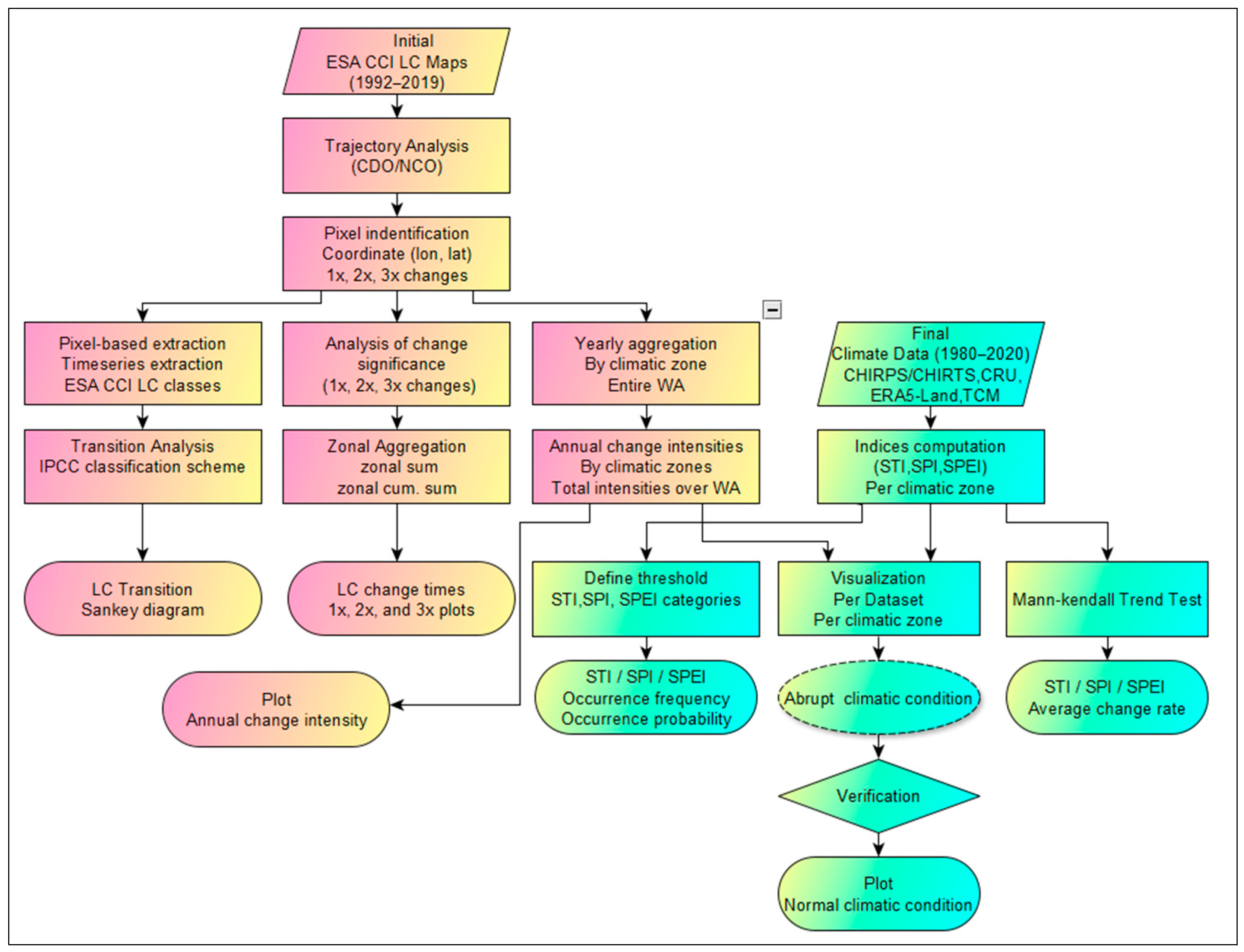


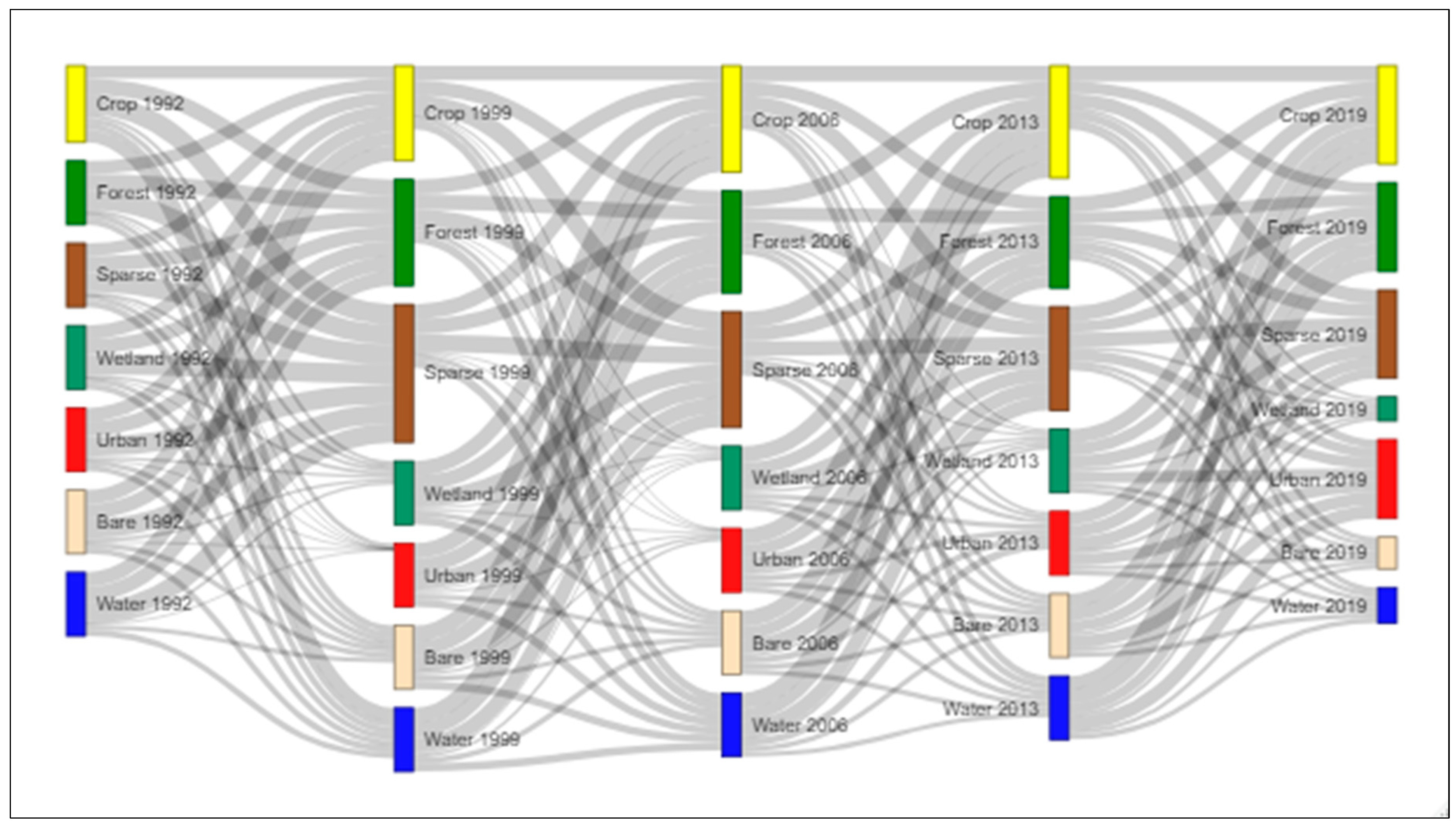
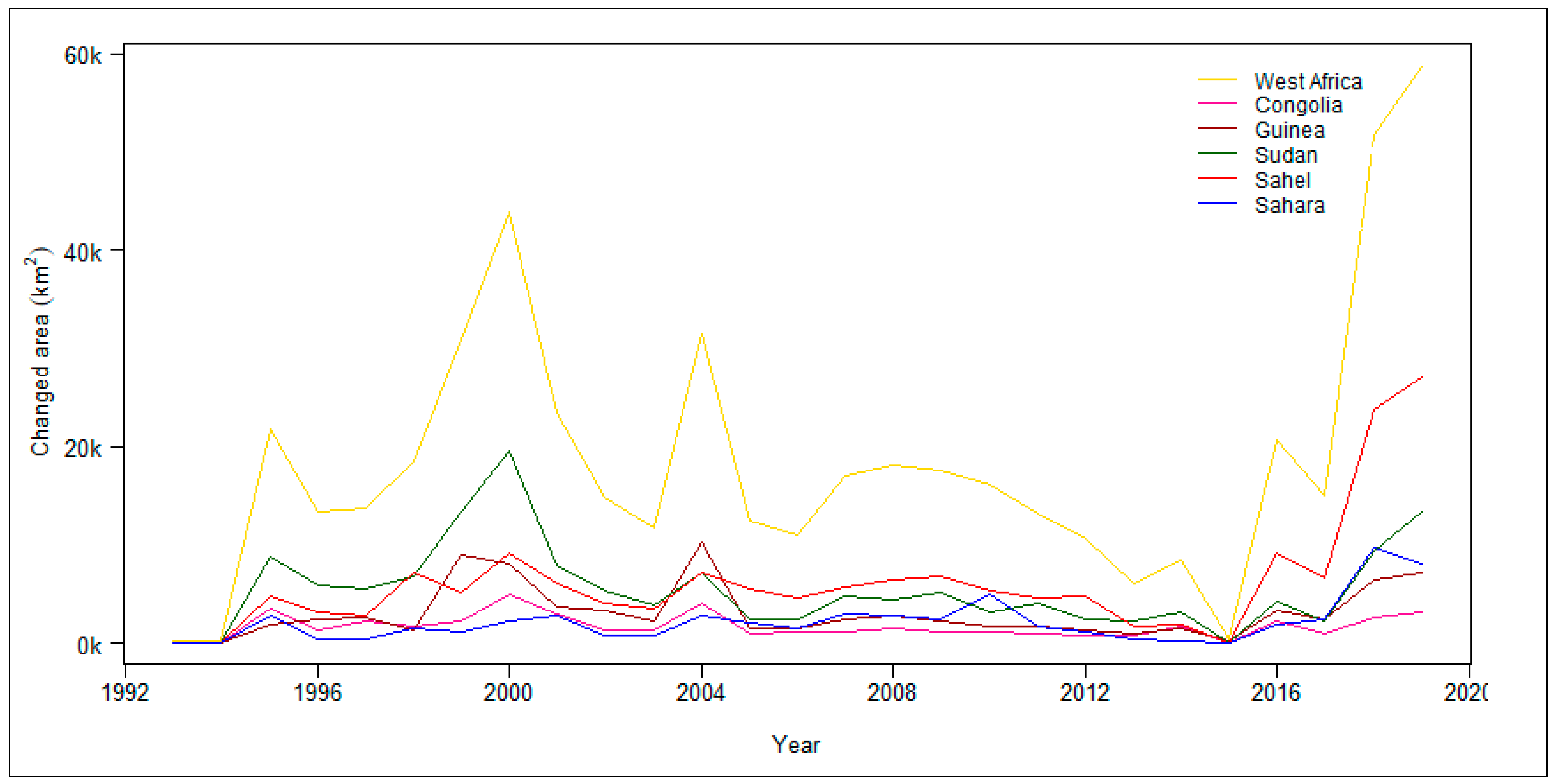
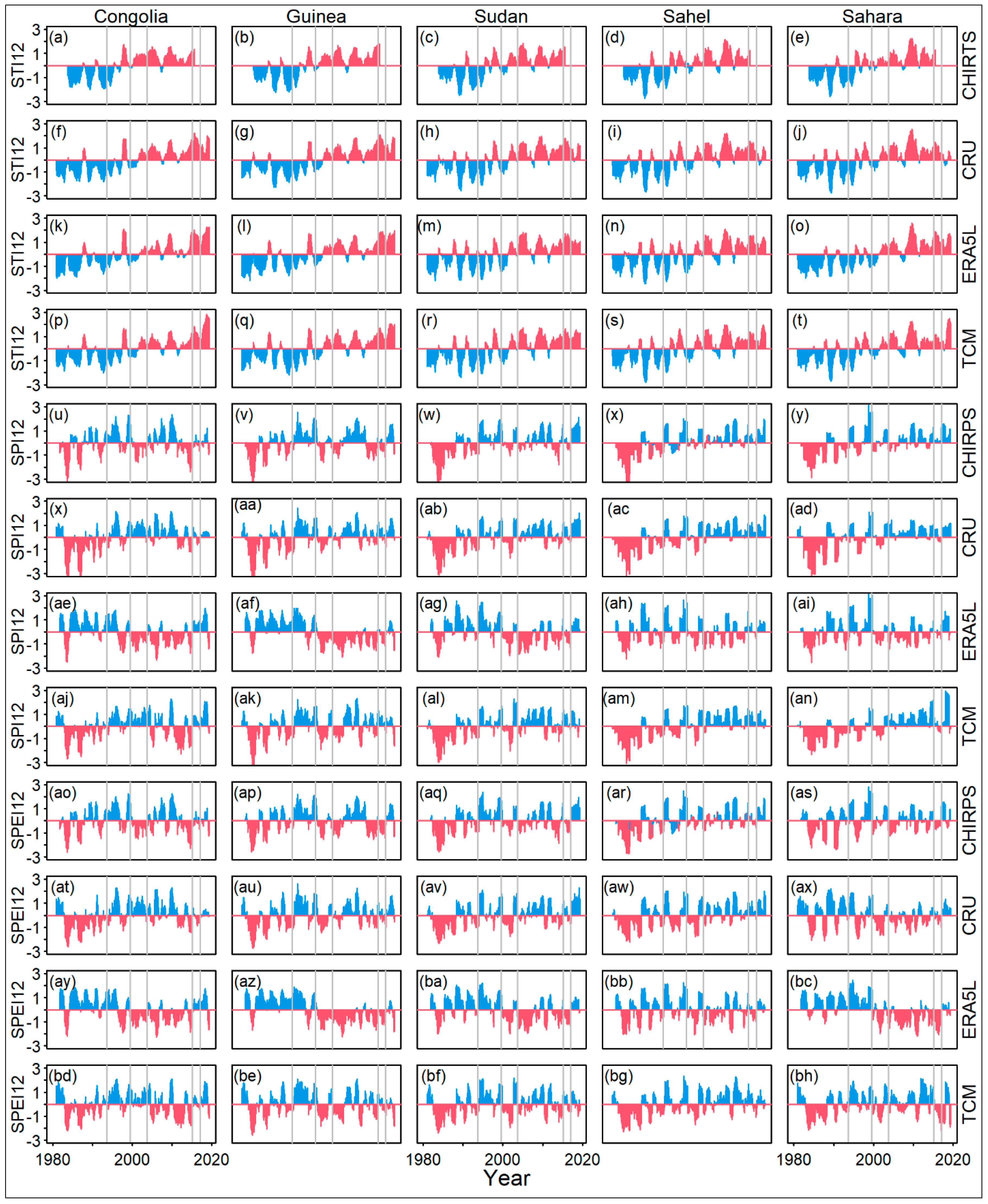

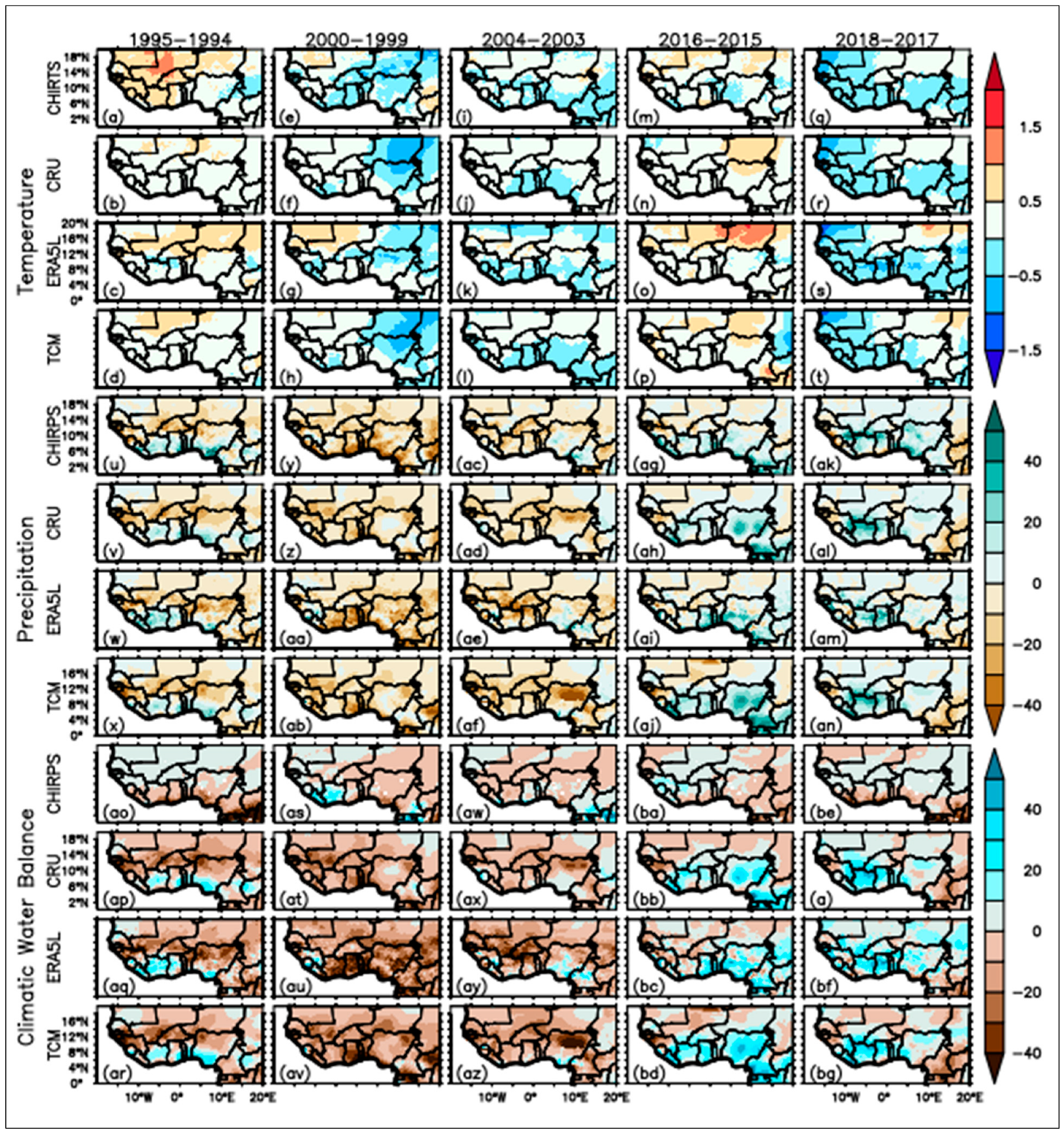
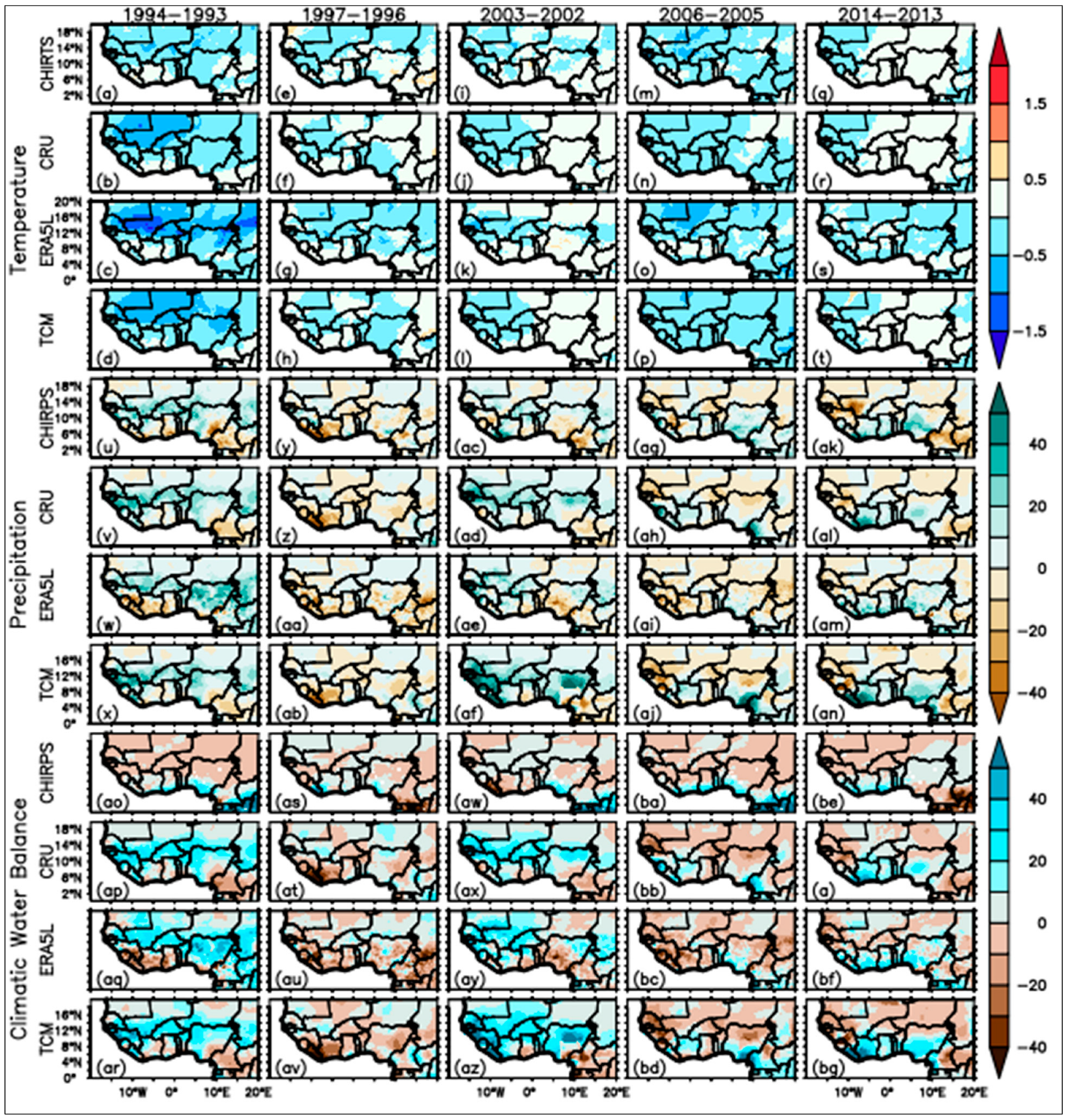
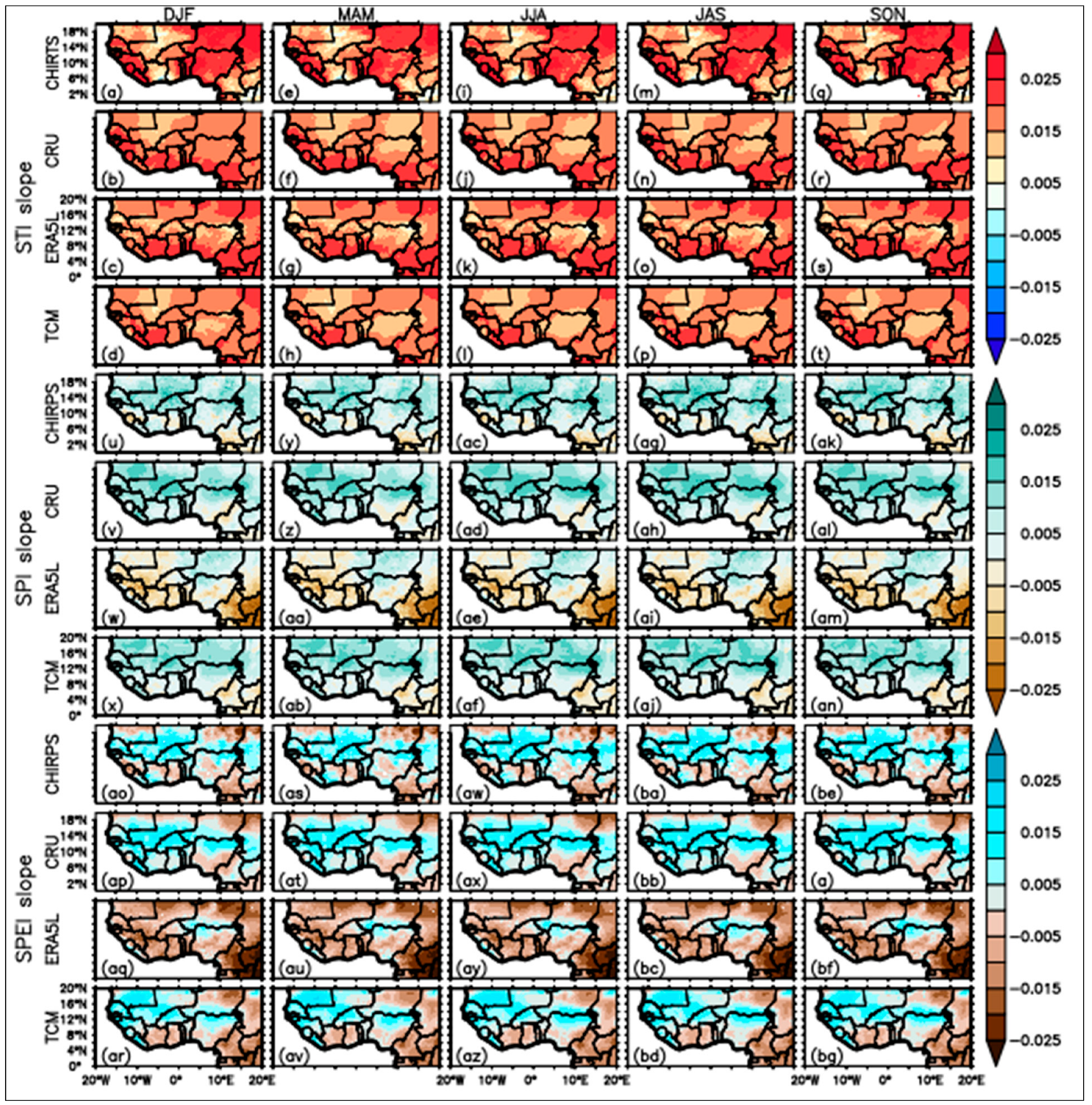
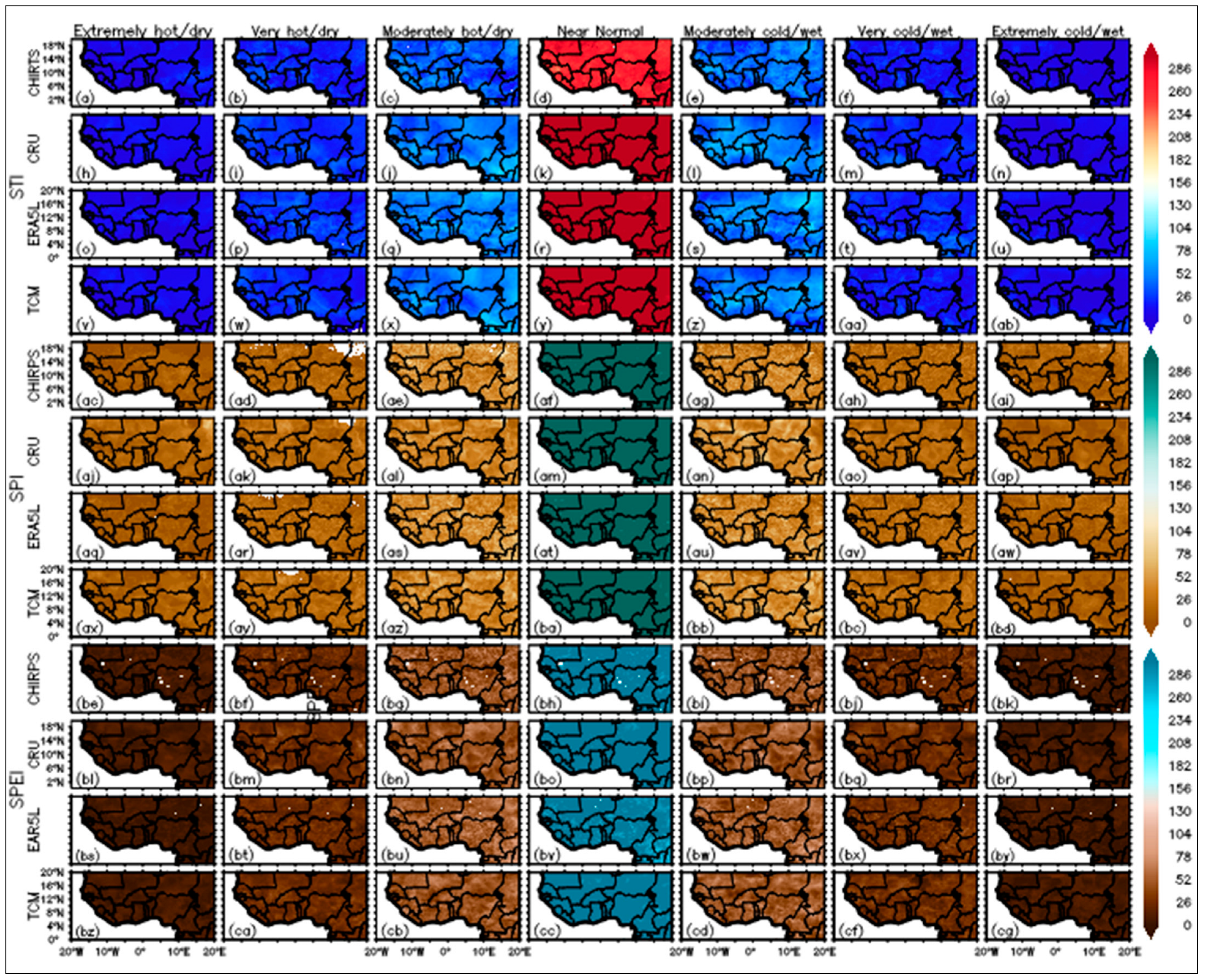
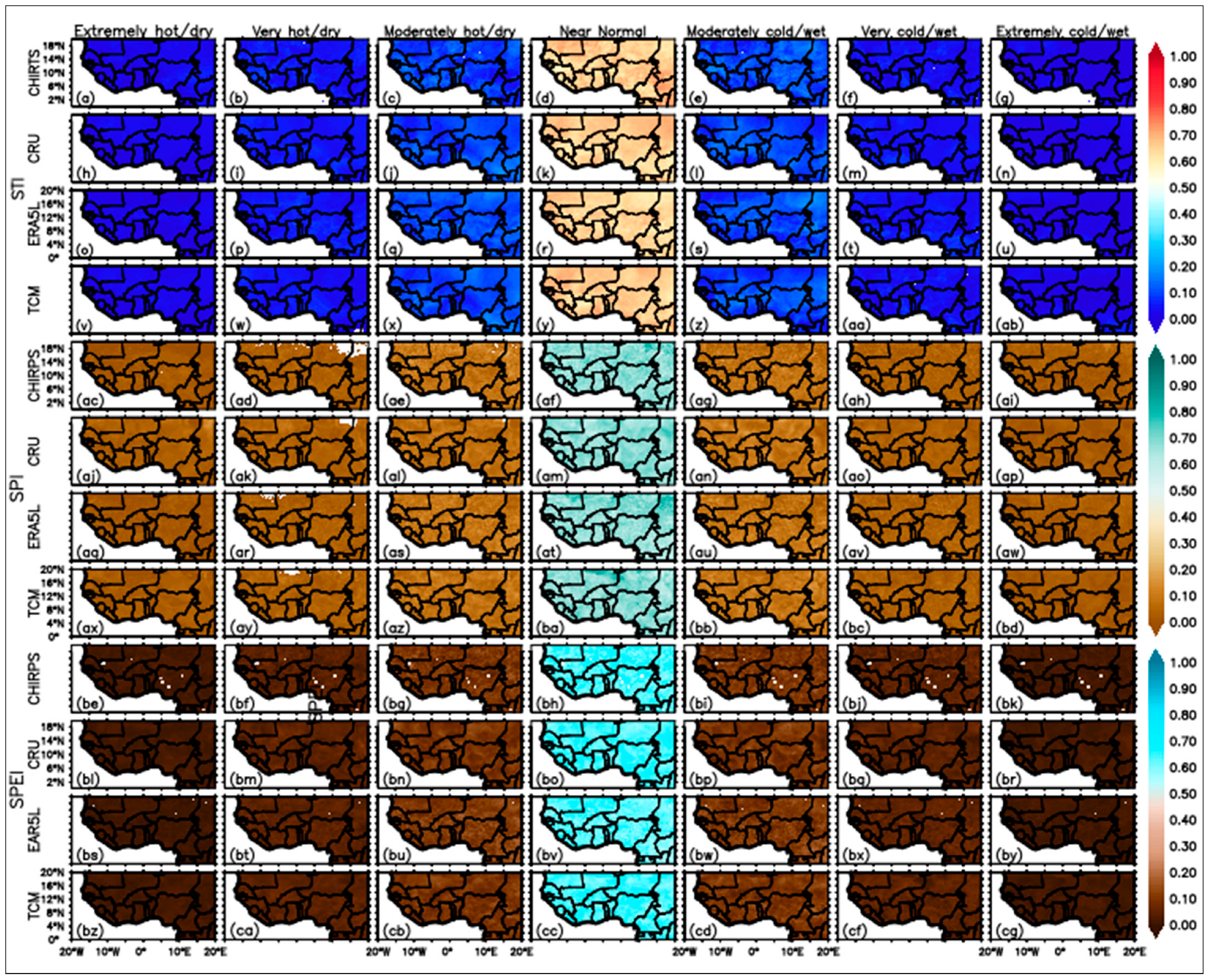
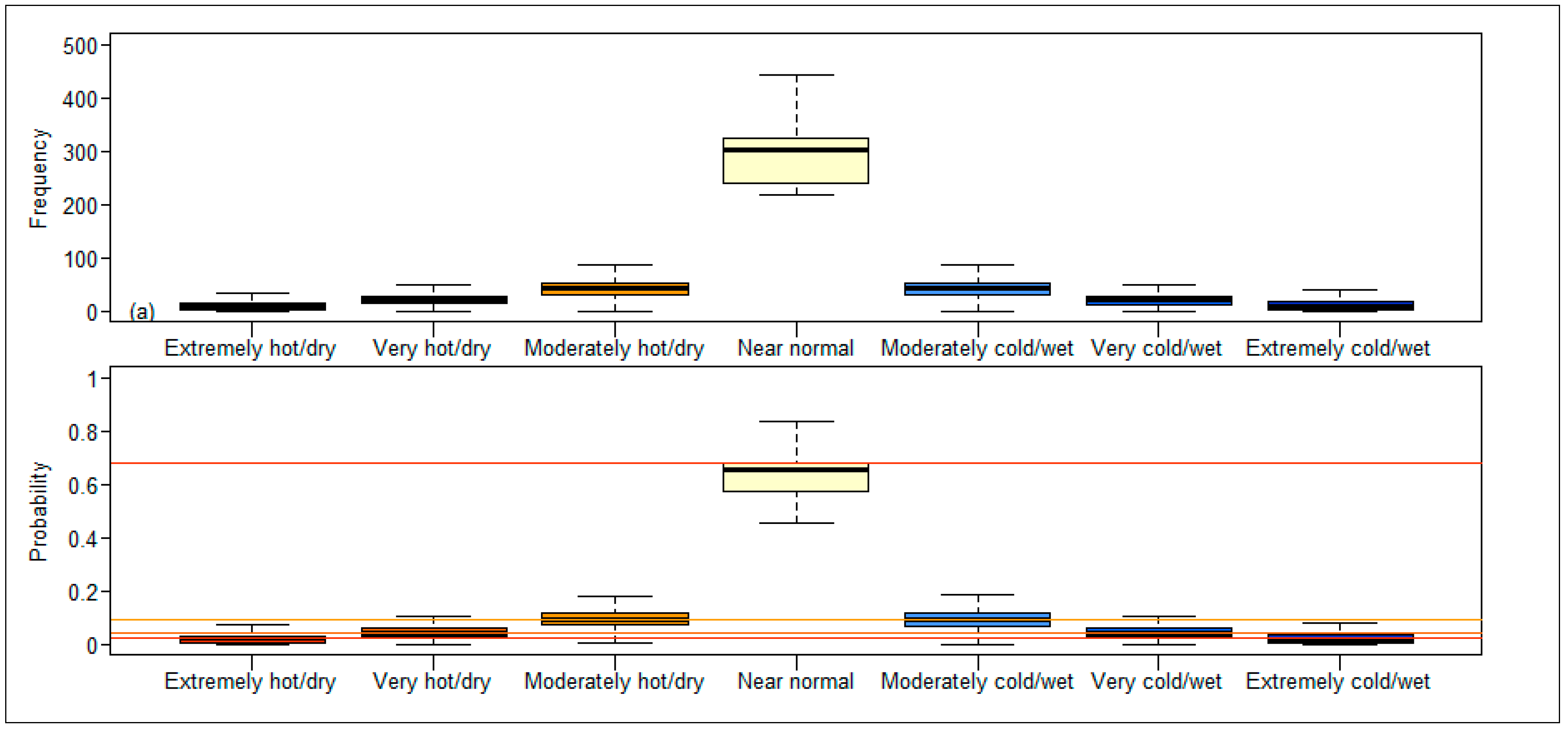
| SPI/SPEI | Cumulative Probability | Interpretation | Classification | Probability of Occurrence |
|---|---|---|---|---|
| +2.0 | 0.9772 | Extremely wet | SPI/SPEI +2.0 | 0.023 |
| +1.5 | 0.9332 | Very wet | +1.5 SPI/SPEI < +2.0 | 0.044 |
| +1.0 | 0.8413 | Moderately wet | +1.0 SPI/SPEI < +1.5 | 0.092 |
| 0.0 | 0.5000 | Near normal | −1.0 > SPI/SPEI < +1.0 | 0.682 |
| −1.0 | 0.1587 | Moderately dry | −1.0 SPI/SPEI > −1.5 | 0.092 |
| −1.5 | 0.0668 | Very dry | −1.5 SPI/SPEI > −2.0 | 0.044 |
| −2.0 | 0.0228 | Extremely dry | −2.0 SPI/SPEI | 0.023 |
| STI | Cumulative Probability | Interpretation | Classification | Probability of Occurrence |
|---|---|---|---|---|
| +2.0 | 0.9772 | Extremely hot | STI +2.0 | 0.023 |
| +1.5 | 0.9332 | Very hot | +1.5 STI < +2.0 | 0.044 |
| +1.0 | 0.8413 | Moderately hot | +1.0 STI < +1.5 | 0.092 |
| 0.0 | 0.5000 | Near normal | −1.0 > STI < +1.0 | 0.682 |
| −1.0 | 0.1587 | Moderately cold | −1.0 STI > −1.5 | 0.092 |
| −1.5 | 0.0668 | Very cold | −1.5 STI > −2.0 | 0.044 |
| −2.0 | 0.0228 | Extremely cold | −2.0 STI | 0.023 |
| Scenario | Condition | T/°C | ∆T/°C | P/mmy−1 | ∆P/mmyr−1 | CWB/mmy−1 | ∆CWB/mm | ∆Area/km2 |
|---|---|---|---|---|---|---|---|---|
| Wet | change | −1.0–1.0 | 2 | 0–+50 | up to 50 | 0–+50 | up to 50 | 45,039–52,133 |
| increase | 0–1.5 | 1.5 | 0–+50 | up to 50 | 0–+50 | up to 50 | 20,935–22,127 | |
| change | −0.5– 0.5 | 1.0 | 0–+50 | up to 50 | 0–+50 | up to 50 | 31,843 | |
| Dry | change | −1.0–1.0 | 2.0 | −50–0 | up to −50 | −50–0 | up to −50 | 45,039–52,133 |
| increase | 0–1.5 | 1.5 | −50–0 | up to −50 | −50–0 | up to −50 | 20,935–22,127 | |
| change | −0.5–0.5 | 1.0 | −50–0 | up to −50 | −50–0 | up to −50 | 31,843 |
Disclaimer/Publisher’s Note: The statements, opinions and data contained in all publications are solely those of the individual author(s) and contributor(s) and not of MDPI and/or the editor(s). MDPI and/or the editor(s) disclaim responsibility for any injury to people or property resulting from any ideas, methods, instructions or products referred to in the content. |
© 2023 by the authors. Licensee MDPI, Basel, Switzerland. This article is an open access article distributed under the terms and conditions of the Creative Commons Attribution (CC BY) license (https://creativecommons.org/licenses/by/4.0/).
Share and Cite
Mortey, E.M.; Annor, T.; Arnault, J.; Inoussa, M.M.; Madougou, S.; Kunstmann, H.; Nyantakyi, E.K. Interactions between Climate and Land Cover Change over West Africa. Land 2023, 12, 355. https://doi.org/10.3390/land12020355
Mortey EM, Annor T, Arnault J, Inoussa MM, Madougou S, Kunstmann H, Nyantakyi EK. Interactions between Climate and Land Cover Change over West Africa. Land. 2023; 12(2):355. https://doi.org/10.3390/land12020355
Chicago/Turabian StyleMortey, Eric Mensah, Thompson Annor, Joël Arnault, Maman Maarouhi Inoussa, Saïdou Madougou, Harald Kunstmann, and Emmanuel Kwesi Nyantakyi. 2023. "Interactions between Climate and Land Cover Change over West Africa" Land 12, no. 2: 355. https://doi.org/10.3390/land12020355
APA StyleMortey, E. M., Annor, T., Arnault, J., Inoussa, M. M., Madougou, S., Kunstmann, H., & Nyantakyi, E. K. (2023). Interactions between Climate and Land Cover Change over West Africa. Land, 12(2), 355. https://doi.org/10.3390/land12020355







